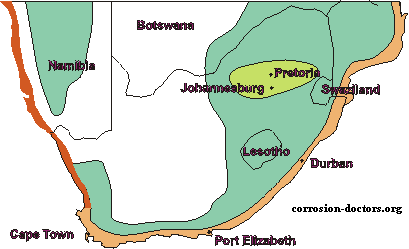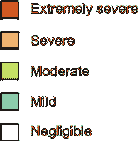
 |
This corrosion severity map of South Africa schematically summarizes 20 years of atmospheric exposure testing. The coastal regions extending some 4-5 km inland tend to be most corrosive due to the effect of wind swept chlorides. High humidity levels tend to exacerbate the detrimental effects of such chlorides.


The two major types of pollution in South Africa are air and marine pollution. The industrial sector is the prime contributor to air pollution. More than 90% of South Africa's electricity is generated from the combustion of coal that contains approximately 1.2% sulfur and up to 45% ash. Coal combustion can lead to particulate matter in the air, as well as contribute to acid rain. While major cities in South Africa do not possess pollution levels comparable to many major cities in China, India or Mexico, pollutant levels are not insignificant. Nitrogen dioxide levels in Capetown, South Africa, for instance, were significantly higher than those measured in Calcutta, and surpassed the World Health Organization's annual mean guideline for air quality standard of 50 micrograms per cubic meter. In addition to industrial pollution, low-level atmospheric pollution often results from coal combustion in stoves, as well as coal-heated boilers that are found in hospitals and factories. Regulations apply to diesel-powered vehicles and are geared towards ensuring proper maintenance. Enforcement, however, is weak and sporadic.
South Africa also must concern itself with marine pollution. South Africa is especially vulnerable to oil spills due to the high volume of oil transported around the country's coasts by ship from the Middle East to Europe and the Americas. The South African Department of Transport and the Department of Environmental Affairs and Tourism cooperate to ensure both prevention of oil spills and clean-up in the event of accidents. Measures supported by the Department of Transport include the maintenance of at least a 12 mile distance from the South African coast, prosecution of ship owners if any oil is discharged from their ships, control of aircraft patrols over shipping lanes, and contingency plans for any oil spills that occur.
South Africa also experiences negative environmental impacts from mining activities. Pollution from mining activities is probably the most direct cause of groundwater pollution in South Africa. Furthermore, small waste coal dumps cause both pollution and safety problems, as waste coal may spontaneously ignite. (reference)
Other regions and countries: Argentina, Brazil, Canada, Central America, Chile, China, Colombia, Cuba, France, Germany, India, Italy, Japan, Mexico, New Zealand, North America, Portugal, Russia, Saudi Arabia, South Africa, Spain, Sweden, UK, USA, Venezuela
 |
 |